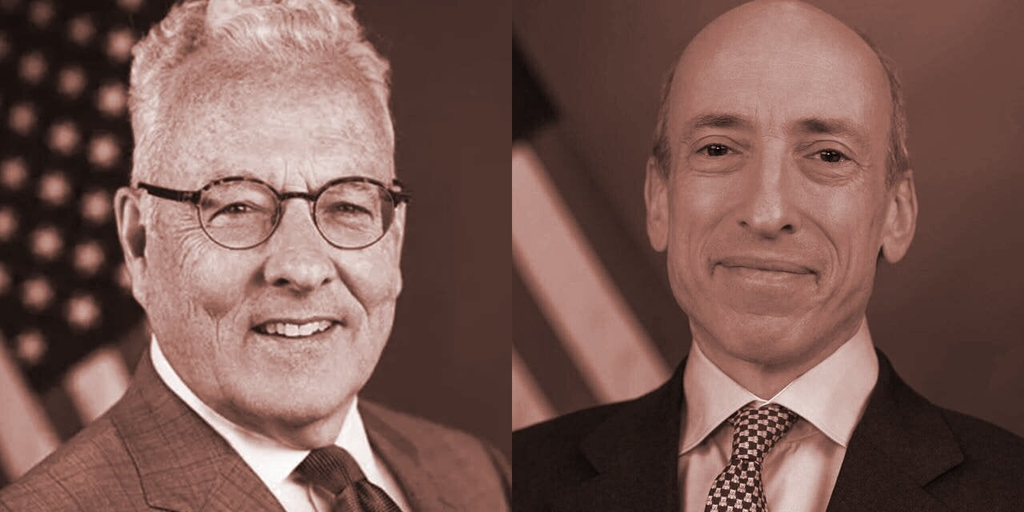Nearly five years ago, SEC official Bill Himan stood on stage at a Yahoo Finance crypto summit in San Francisco and delivered a prepared speech that concluded that Ethereum (ETH) is not a security. A footnote on the SEC’s website clarified that the speech “expresses the author’s views and does not necessarily reflect those of the Commission,” but it was nonetheless taken exactly that way. Hinman’s speech came just one week after then-SEC chair Jay Clayton said that the SEC does not view Bitcoin or other cryptocurrencies as securities, as opposed to tokens, Clayton said, “where I give you my money, and you go off and make a venture, and in return for giving you my money I say ‘you can get a return’—that is a security.”
But Gary Gensler, the current SEC chair and scourge of crypto builders, has made clear that he does not share Hinman’s view. He views “everything other than Bitcoin” as a security. Last fall, just one day after Ethereum completed its merge to become a proof-of-stake network, Gensler said that the native tokens of networks that use staking also look like securities, since “the investing public is anticipating profits based on the efforts of others.”
And Gensler is using as his north star the same test that Hinman and Clayton used: a 77-year-old lawsuit involving a Florida citrus grove.
The “Howey Test” has become an infamous bogeyman for everyone in crypto, and while the industry would like it to go away, it is clear that isn’t going to happen any time soon.
Hinman and Clayton are both long gone from the SEC and have moved on to advise crypto firms (naturally). But Howey remains, and Gensler has cited it to make the case that all of crypto falls under SEC jurisdiction—even though just last month, his counterpart at the CFTC said ETH is a commodity.
(Ironically, Hinman’s speech in June 2018 was called “When Gary Met Howey,” but he was referencing a 1985 case involving Gary Plastic Packaging that showed a non-security can become a security depending on how it’s marketed; Hinman couldn’t know that in a few years, a different Gary would wield Howey as a hammer against an entire trillion-dollar industry.)
The thrust of Howey is that an asset becomes an investment contract when it is marketed or sold with the expectation of profit thanks to the work of the seller or a third party. The citrus grove itself was not a security, but shares in the citrus grove were. Hinman argued that putting aside the initial Ethereum fundraise in 2014 that brought in $18 million, the network had since become sufficiently decentralized to rule out current sales of ETH as securities offerings. Gensler does not appear to agree, but more importantly—and more damaging for most new crypto projects—is that all other token sales built on Ethereum do look pretty clearly like securities under the Howey definition. Speculators buy them in the hopes that the token will go up based on the perceived success of the project.
But wait! What if the token is genuinely used in the project’s ecosystem, and has real utility beyond price speculation? Doesn’t matter, as Hinman said in 2018 way before Gensler showed up: “Simply labeling a digital asset a ‘utility token’ does not turn the asset into something that is not a security.” In other words: call your token whatever you want, the SEC still thinks it’s a security.
People in crypto like to say that the SEC has not given “clear guidelines” for crypto projects, but the truth is that it has. Its guiding light is the Howey Test—the industry just doesn’t like it. Gensler said in front of Congress just last week: No new rules are coming, because “the regulations actually already exist.”
Another problem people raise with Howey is that it’s too damn old to be applied fairly anymore, but even Coinbase Chief Legal Officer Paul Grewal, a former California magistrate judge, said recently on our gm podcast that the issue with Howey is not its age: “I love legal precedents, even if they are decades old. And in some cases I love them even more if they are centuries old. So I have no problem with Howey or any other precedent simply because of its age.”
The real problem with Howey is how it’s being applied to brand new technology.
“When it comes to the operation of a blockchain-based technology that underlies most digital assets, there is often, I think, a confusion about the role of the promoter, a confusion about what is driving any returns that might accrue to the holder of tokens, and a confusion about fundamentally how these assets work, and what real utility they bring to the networks,,” Grewal said. “When it comes to networks that are based on a proof-of-stake consensus mechanism, there’s a very important role that these tokens play, which is to make sure that the networks are secure, that the transactions that are confirmed on the network are accurate.”
So, is it always fair to chalk up a token’s gains solely to the efforts of the project behind it? What about when the token holders are real participants in the project’s success? That is the distinction many new projects are hoping excludes their token from the SEC’s clutches, but for now, Gensler has not indicated that it makes any difference to him.
That approach certainly didn’t work for LBRY, which argued that its token “functioned as an essential part of the LBRY blockchain” and still lost its case against the SEC, and lost bad—as University of Kentucky law professor Brian Frye told Decrypt, “The district court almost entirely deferred to the SEC… He ruled for the SEC on literally everything, with no caveats.”
Most people you ask believe Gary Gensler is angling for a bigger job in government. But there’s no guarantee Gensler’s successor as SEC chair won’t also happily apply Howey to crypto. (Remember: when Gensler first took the job, people in crypto were initially optimistic because he had taught a blockchain course at MIT; don’t assume the next chair will be any friendlier.)
The entire crypto industry must reckon with Howey, rather than hope it just goes away. Some projects are doing that by calling their coin a governance token, emphasizing holder participation; others, like Coinbase, are promising to fight the SEC head on, which should be applauded by the industry; many others are only offering their token outside the U.S..
For now, it’s clear the current regulatory environment in the U.S. is pushing crypto projects overseas. What happens next with regulation will be the most important determinant for the future of Web3 innovation in America. For the time being, Howey is alive and kicking.
Stay on top of crypto news, get daily updates in your inbox.
Source: https://decrypt.co/125761/crypto-projects-must-reckon-with-sec-howey-test-for-securities



